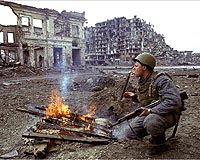| . |  |
. |
Papa Air Base, Hungary (SPX) Jul 29, 2009 Senior diplomatic and defense officials representing 12 nations as well as NATO witnessed July 27 the official activation of a first-of-its-kind multinational strategic airlift unit at Papa Air Base, Hungary. "I want to extend my thanks to all of the nations that chose to participate in SAC," said Ambassador Claudio Bisogniero, NATO deputy secretary general, referring to the Strategic Airlift Capability program formalized 2006. "Because of your commitment, we are well-positioned to provide aid anywhere, at any time, and on any mission + humanitarian, disaster relief, or peacekeeping." The nations committed to the 30-year SAC Program built the program's multinational operational-level unit, known as the Heavy Airlift Wing or HAW, in just 10 months. The purpose was to collectively create a heavy airlift solution with global reach to meet national obligations to the European Union, United Nations and NATO. Primary among those obligations for all the participants is support to the International Security Assistance Force in Afghanistan. "In building this program, the twelve nations forged an unshakable bond," said U.S. Air Force Brig. Gen. Richard Johnston, chairman of the SAC Steering Board. "This unshakable bond is gathered here at Papa to celebrate a significant milestone in military aviation. This is your day, your nation's day, and each and every nation should be proud to have brought this vision to reality." The SAC program, which will operate independently of NATO's military command, includes NATO member nations Bulgaria, Estonia, Hungary, Lithuania, the Netherlands, Norway, Poland, Romania, Slovenia and the United States, as well as Partnership for Peace nations Finland and Sweden. The nations' varying investments in the SAC Program dictate their proportionate share of the annual flying hours on three jointly acquired Boeing C-17 Globemaster III aircraft. The first C-17, SAC 01, landed at Papa AB July 18 under the control of HAW pilots from Norway, Sweden and the U.S. Boeing will deliver SAC's two remaining C-17s in September and October. Each nation also contributed a proportionate share of the unit's 131 personnel. "For nearly a year now, airmen from 12 nations have worked as a team here in Papa, blending their varied skills, military experiences and cultures into a new form of multinational military unit," explained the HAW's first commander, U.S. Air Force Col. John Zazworsky, in his multinational capacity. "The team has consistently focused on being able to conduct strategic airlift missions as soon as the first aircraft was delivered. Now that we have reached that milestone, we have the strong sense that we are creating a model for future cooperative military efforts." SAC 01 will begin operational missions in support of the nations' requirements in early August and anticipates flying roughly 630 hours before the end of 2009 and more than 3,100 flying hours in 2010, all of which will be flown by multinational aircrews regardless of the nation to which the mission belongs. Many of the already-scheduled missions will fulfill the participating nations' commitments to ISAF. A typical mission transporting troops, mechanized firepower and oversized equipment weighing tens of tons from Papa to Afghanistan and back requires roughly 15 flight hours. The Republic of Hungary plays a significant role in the SAC program as host to the main operating base of the newly activated HAW and to its personnel and their families. It will also register the SAC aircraft, the tail flash of which presents the nation's flag in stripes of red, white and green. To facilitate the HAW's mission, the Hungarian air force will manage the Papa airfield, air traffic control operations and base infrastructure support. A Boeing team assigned to Papa AB will provide material management, flight line maintenance and other support for the wing's C-17s. And the NATO Airlift Management Agency or NAMA, an organization of roughly three dozen individuals, will handle acquisition, logistics support and financial matters. According to SAC officials, the program's approach to shared use of strategic airlift assets allows participating nations to achieve greater efficiencies in defense investment and operational capacity than otherwise possible. Furthermore, the program provides a model for future consortium acquisition and management of expensive defense capabilities and for future combined operations. Share This Article With Planet Earth
Related Links - The latest in Military Technology for the 21st century at SpaceWar.com
 Outside View: Counterinsurgency challenges
Outside View: Counterinsurgency challengesWashington (UPI) Jul 28, 2009 The effective execution of full spectrum counterinsurgency operations remains a challenge for the U.S. military. U.S. Army doctrine states that successful COIN operations depend on the synchronized application of combat, security, political, economic, psychological and civic actions. To achieve unity of effort, these activities need to be coordinated across military services, government ... read more |
|
| The content herein, unless otherwise known to be public domain, are Copyright 1995-2009 - SpaceDaily. AFP and UPI Wire Stories are copyright Agence France-Presse and United Press International. ESA Portal Reports are copyright European Space Agency. All NASA sourced material is public domain. Additional copyrights may apply in whole or part to other bona fide parties. Advertising does not imply endorsement,agreement or approval of any opinions, statements or information provided by SpaceDaily on any Web page published or hosted by SpaceDaily. Privacy Statement |